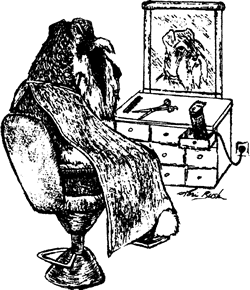 Whichever size of Schnauzer you choose regular maintenance is very important and should not be made too stressful for either you or your dog. Firm but kind handling is of the utmost importance and your primary aim should be to gain a good rapport with your dog making grooming an enjoyable experience for you both rather than a tedious chore. Although they won’t need a lot of grooming early on, get your puppy used to being handled, look in their mouth and ears, check their feet, brush and comb them, this will pay dividends later on when they visit the vet or go to be groomed.
Whichever size of Schnauzer you choose regular maintenance is very important and should not be made too stressful for either you or your dog. Firm but kind handling is of the utmost importance and your primary aim should be to gain a good rapport with your dog making grooming an enjoyable experience for you both rather than a tedious chore. Although they won’t need a lot of grooming early on, get your puppy used to being handled, look in their mouth and ears, check their feet, brush and comb them, this will pay dividends later on when they visit the vet or go to be groomed.
A set routine is the best way to tackle the job at hand ideally with somewhere undisturbed to work, preferably not the kitchen as some people might object to dog hairs in their supper!
You will need somewhere to stand your dog on to groom them, either a work surface or a good solid table, there is nothing more off putting to a dog than a wobbly table. Use something non-slip to stand them on such as a rubber bath mat. The next thing you will need is lots of patience especially with puppies who have a very low boredom threshold. Ideally you should carry out your grooming routine at least once a week, probably more often with puppies, taking the opportunity to check your dog over for anything unusual such as grass seed, cuts etc.
The main equipment you will need is a terrier pad for the main body coat, a slicker brush for the beard and furnishings and a metal comb. Start with the head, clean away any ‘sleep’ from the eyes, check that the ears are free from hair and wax. Many people find removing the hair from their dogs ears quite daunting and if you are nervous about this is probably best not to use tweezers or forceps but any hair that can be removed with your fingers will be beneficial to your dog in between visits to your groomer.
Next check you dogs feet, looking between pads to check for grass seeds, cuts, matted hair etc. It’s a good idea to trim away any excess hair between pads using a pair of blunt ended scissors, as this can be very uncomfortable for you dog if left unchecked. Nails should be kept quite short, at least level with the pads when the dog is standing four square. Again some people find this task a bit daunting and if your dog is being regularly trimmed a good groomer will always check to see if the nails need trimming. If you dog gets lots of walks on hard ground they will probably wear them down naturally but if they have dew claws these will definitely need regular trimming. If you are a bit nervous about tackling this task guillotine clippers are probably the safest bet as they have a safety guard preventing you from cutting too much. The ‘quick’, which is the vein running through the nail, grows with the nail and if the dog has black nails it is impossible to see. The best advice is ‘little and often’.
The last part or your grooming routine is a thorough brush and comb, using the terrier pad on the main body brushing with the lie of the coat. Next, brush the beard and furnishing through thoroughly using the slicker brush followed by a good comb through. Pay particular attention to friction areas i.e. under the arms and the groin area, as this is where the hair tends to knot very easily.
Last but not least, give your dog lots of praise and maybe even a tasty treat!
For those owners aspiring to trim their own Miniature these charts may prove helpful:
Grooming Chart
